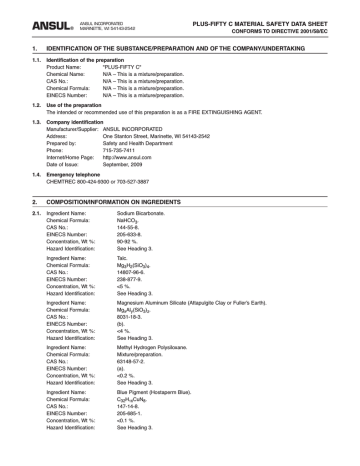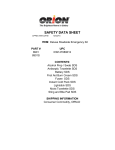First Alert 10-B:C MSDS
Add to my manuals5 Pages
First Alert 10-B:C
The First Alert 10-B:C is a carbon monoxide (CO) alarm that is designed to protect you and your family from the dangers of CO poisoning. CO is a colorless, odorless gas that can be deadly if inhaled. The 10-B:C is a battery-operated alarm that will sound a loud alarm if CO levels in your home reach dangerous levels.
The 10-B:C is easy to install and use. Simply mount it on a wall or ceiling in a central location in your home. The alarm will automatically turn on when you insert the batteries. The 10-B:C has a test button that you can use to test the alarm's functionality.
advertisement

ANSUL
®
ANSUL INCORPORATED
MARINETTE, WI 54143-2542
PLUS-FIFTY C MATERIAL SAFETY DATA SHEET
CONFORMS TO DIRECTIVE 2001/58/EC
1.
IDENTIFICATION OF THE SUBSTANCE/PREPARATION AND OF THE COMPANY/UNDERTAKING
1.1.
Identification of the preparation
Product Name: "PLUS-FIFTY C"
Chemical Name:
CAS No.:
N/A – This is a mixture/preparation.
N/A – This is a mixture/preparation.
Chemical Formula:
EINECS Number:
N/A – This is a mixture/preparation.
N/A – This is a mixture/preparation.
1.2.
Use of the preparation
The intended or recommended use of this preparation is as a FIRE EXTINGUISHING AGENT.
1.3.
Company identification
Manufacturer/Supplier: ANSUL INCORPORATED
Address:
Prepared by:
One Stanton Street, Marinette, WI 54143-2542
Safety and Health Department
Phone: 715-735-7411
Internet/Home Page: http://www.ansul.com
Date of Issue: September, 2009
1.4.
Emergency telephone
CHEMTREC 800-424-9300 or 703-527-3887
2.
COMPOSITION/INFORMATION ON INGREDIENTS
2.1.
Ingredient Name:
Chemical Formula:
CAS No.:
EINECS Number:
Concentration, Wt %:
Hazard Identification:
Ingredient Name:
Chemical Formula:
CAS No.:
EINECS Number:
Concentration, Wt %:
Hazard Identification:
Ingredient Name:
Chemical Formula:
CAS No.:
EINECS Number:
Concentration, Wt %:
Hazard Identification:
Ingredient Name:
Chemical Formula:
CAS No.:
EINECS Number:
Concentration, Wt %:
Hazard Identification:
Ingredient Name:
Chemical Formula:
CAS No.:
EINECS Number:
Concentration, Wt %:
Hazard Identification:
Sodium Bicarbonate.
NaHCO
3
.
144-55-8.
205-633-8.
90-92 %.
See Heading 3.
Talc.
Mg
3
H
2
(SiO
3
)
4
.
14807-96-6.
238-877-9.
<5 %.
See Heading 3.
Magnesium Aluminum Silicate (Attapulgite Clay or Fuller’s Earth).
Mg x
Al y
(SiO
3
) z
.
8031-18-3.
(b).
<4 %.
See Heading 3.
Methyl Hydrogen Polysiloxane.
Mixture/preparation.
63148-57-2.
(a).
<0.2 %.
See Heading 3.
Blue Pigment (Hostaperm Blue).
C
32
H
16
CuN
8
.
147-14-8.
205-685-1.
<0.1 %.
See Heading 3.
PLUS-FIFTY C (Continued) Page 2
[2.2. (i) There are NO substances presenting a health or environmental hazard within the meaning of Directive 67/548/EEC, in concentrations equal to or greater than those laid down in the table set out in Article 3(3) of Directive 1999/45/EC, nor with lower limits given in Annex I to Directive 67/548/EEC or in Annexes II, III or V to Directive 1999/45/EC.
(ii) There are NO substances for which there are Community workplace exposure limits, which are not already included in
(i) above.]
(a) EINECS does not include synthetic polymers (these are registered in EINECS under their building blocks, monomers).
See: 67/548/EEC, article 13; 79/831/EC; and 81/437/EC.
(b) EINECS does not include most naturally occurring raw materials. See: 67/548/EEC, article 13; 79/831/EC; and
81/437/EC.
NOTE: Unless a component presents a severe hazard, it does not need to be considered in the MSDS if the concentration is less than 1%. [According to Directive 1999/45/EC].
3.
HAZARDS IDENTIFICATION
FOR HUMANS:
Product:
This preparation is not classified as dangerous according to Directive 1999/45/EC.
Limit Values for Exposure:
Nuisance dust limit: OSHA TWA: 15 mg/m 3 .
ACGIH TLV-TWA: 10 mg/m 3 .
Neither this preparation nor the substances contained in it have been listed as carcinogenic by National Toxicology
Program, IARC, or OSHA.
AS PART OF GOOD INDUSTRIAL AND PERSONAL HYGIENE AND SAFETY PROCEDURE, avoid all unnecessary exposure to the chemical substance and ensure prompt removal from skin, eyes, and clothing.
SIGNS AND SYMPTOMS:
Acute Exposure:
Eye Contact:
Skin Contact:
Mildly irritating for short periods of time.
May be mildly irritating.
Inhalation:
Ingestion:
May be irritating to mucous membranes.
Not an expected route of entry.
Chronic Overexposure: Lungs, gastrointestinal, and kidney can be affected.
MEDICAL CONDITIONS GENERALLY AGGRAVATED BY EXPOSURE: None known.
FOR ENVIRONMENT:
No adverse effects expected.
4.
FIRST AID MEASURES
Eye Contact:
Skin Contact:
Inhalation:
Ingestion:
Flush with water for a minimum of 15 minutes while holding lids open. If irritation persists seek medical attention.
Wash affected area with soap and water. If irritation persists seek medical attention.
Remove from exposure. If irritation persists seek medical attention.
If patient is conscious, dilute by drinking large quantities of water.
5.
FIRE-FIGHTING MEASURES
This preparation is an extinguishing media.
There are NO extinguishing media which must not be used for safety reasons.
NO special protective equipment is needed for fire-fighters. Wear protective equipment appropriate for the fire conditions.
6.
ACCIDENTAL RELEASE MEASURES
For personal protection: Prevent skin and eye contact, see Heading 8.
Clean up: Sweep up and reuse or place in a closed container for disposal, see Heading 13.
NO harm to the environment is expected from an accidental release of this preparation.
PLUS-FIFTY C (Continued)
7.
HANDLING AND STORAGE
7.1.
Handling
Care should be taken in handling all chemical substances and preparations.
See incompatibility information in Heading 10.
7.2.
Storage
NO special conditions are needed for safe storage.
See incompatibility information in Heading 10.
Store in original container. Keep tightly closed until used.
There is minimal danger to the environment from a storage release.
7.3.
Specific use
The intended or recommended use of this preparation is as a FIRE EXTINGUISHING AGENT.
Page 3
8.
EXPOSURE CONTROLS/PERSONAL PROTECTION
8.1.
Exposure limit values
Nuisance dust limit: OSHA TWA:
ACGIH TLV-TWA:
15 mg/m 3 .
10 mg/m 3 .
8.2.
Exposure controls
8.2.1. Occupational exposure controls
8.2.1.1. Respiratory protection
Dust mask where dustiness is prevalent, or TLV is exceeded. Use mechanical filter respirator if exposure is prolonged. Mechanical ventilation is preferred.
8.2.1.2. Hand protection
None normally needed. Use impervious gloves if irritation occurs.
8.2.1.3. Eye protection
Chemical goggles recommended as mechanical barrier for prolonged exposure.
8.2.1.4. Skin protection
No special equipment is needed.
8.2.2. Environmental exposure controls
No special controls are needed.
9.
PHYSICAL AND CHEMICAL PROPERTIES
9.1.
General information
Appearance:
Odor:
Blue powder.
None.
9.2.
Important health, safety, and environmental information pH: 8.6 (at 20 °C) (1% wt/wt dissolved in water).
Boiling point/boiling range:
Flash point:
Not applicable.
None.
Flammability (solid/gas):
Explosive properties:
Oxidizing properties:
Vapor Pressure:
Not flammable.
Not explosive.
Not an oxidizer.
Not applicable.
Not applicable.
Relative Density:
Solubility:
– Water solubility:
Sodium Bicarbonate:
Completely soluble.
96 g/L (at 20 °C).
– Fat solubility: Not soluble.
Partition coefficient, n-octanol/water: Not applicable.
Viscosity:
Vapor density (Air = 1):
Evaporation rate:
Not applicable.
Not applicable.
Not applicable.
9.3.
Other information
Auto-ignition temperature: Does not ignite.
PLUS-FIFTY C (Continued) Page 4
10.
STABILITY AND REACTIVITY
10.1. Conditions to avoid
There are NO known conditions such as temperature, pressure, light, shock, etc., which may cause a dangerous reaction.
10.2. Materials to avoid
Strong acids, NaK alloy, and NH
4
H
2
PO
4
.
10.3. Hazardous decomposition products
Normally stable.
Hazardous polymerization will NOT occur.
Combustion or decomposition products include carbon dioxide.
11.
TOXICOLOGICAL INFORMATION
This product has not been tested for toxicological effects. Product is treated as a nuisance dust.
Components:
Sodium Bicarbonate:
LD
50
(rat) = 4,220 mg/kg.
Skin irritation (rabbit) = Not irritating.
Skin irritation (human) = Slightly irritating.
Eye irritation (rabbit) = Not irritating.
Eye irritation (human) = Slightly irritating.
May be irritating to mucous membranes and upper respiratory tract.
May be harmful if swallowed in large amounts.
Talc:
May be irritating to eyes, skin, or mucous membranes.
Magnesium Aluminum Silicate (Attapulgite Clay or Fuller’s Earth):
Irritating to eyes, skin, mucous membranes.
Target Organs: Lungs.
12.
ECOLOGICAL INFORMATION
12.1. Ecotoxicity
Not determined.
12.2. Mobility
Not determined.
12.3. Persistence and degradability
Not determined.
12.4. Bioaccumulative potential
Not determined.
12.5. Other adverse effects
Ozone depletion potential: None.
Photochemical ozone creation potential: None
Global warming potential: Carbon dioxide from decomposition or reaction is a global warming gas.
13.
DISPOSAL CONSIDERATIONS
No harm to the environment is expected from this preparation.
Dispose of in compliance with national, regional, and local provisions that may be in force.
14.
TRANSPORT INFORMATION
Hazard Class or Division: Not a hazardous substance.
For additional transport information, contact Ansul Incorporated.
No harm to the environment is expected from this preparation.
PLUS-FIFTY C (Continued) Page 5
15.
REGULATORY INFORMATION
EU Classification: This preparation is not classified as dangerous according to Directive 1999/45/EC.
Nuisance dust limit: OSHA TWA: 15 mg/m 3
ACGIH TLV-TWA: 10 mg/m 3 .
EINECS Status: All components are included in EINECS inventories or are exempt from listing.
EPA TSCA Status All components are included in TSCA inventories or are exempt from listing.
Canadian DSL (Domestic Substances List): All components are included in the DSL or are exempt from listing.
Environmental restrictions:
Restrictions on Marketing and Use:
None are known.
None are known.
Refer to any other national measures that may be relevant.
16.
OTHER INFORMATION
(HMIS) HAZARDOUS MATERIAL IDENTIFICATION SYSTEM RATINGS:
HEALTH:
FLAMMABILITY:
REACTIVITY:
4. Severe Hazard
3. Serious Hazard
2. Moderate Hazard
1. Slight Hazard
0. Minimal Hazard
(WHMIS) CANADIAN WORKPLACE HAZARDOUS MATERIAL
IDENTIFICATION SYSTEM RATINGS:
This product is NOT controlled under the Canadian WHMIS.
Format is from directive 2001/58/EC.
EINECS data is from http://ecb.jrc.it/existing-chemicals/
Data used to compile the data sheet is from Ansul Material Safety Data Sheet, February, 2002.
The EU Classification has been changed in accordance with Directive 1999/45/EC and information in the EINECS ESIS files (Existing Substances Information System).
Toxicological information added from the EINECS ESIS (Existing Substances Information System).
A rating under WHMIS has been added, following the Canadian guidelines.
17.
DISCLAIMER
THE ABOVE INFORMATION IS BELIEVED TO BE CORRECT, BUT DOES NOT PURPORT TO BE ALL INCLUSIVE AND
SHALL BE USED ONLY AS A GUIDE. ANSUL SHALL NOT BE HELD LIABLE FOR ANY DAMAGE RESULTING FROM
HANDLING OR FROM CONTACT WITH THE ABOVE PRODUCT.
MSDS available at http://www.ansul.com
ANSUL is a trademark of Tyco International Ltd. or its affiliates.
TYCO FIRE SUPPRESSION & BUILDING PRODUCTS, MARINETTE, WI 54143-2542 715-735-7411 Form No. F-9754-5 Copyright ©2009 Tyco International Ltd.
advertisement
* Your assessment is very important for improving the workof artificial intelligence, which forms the content of this project
